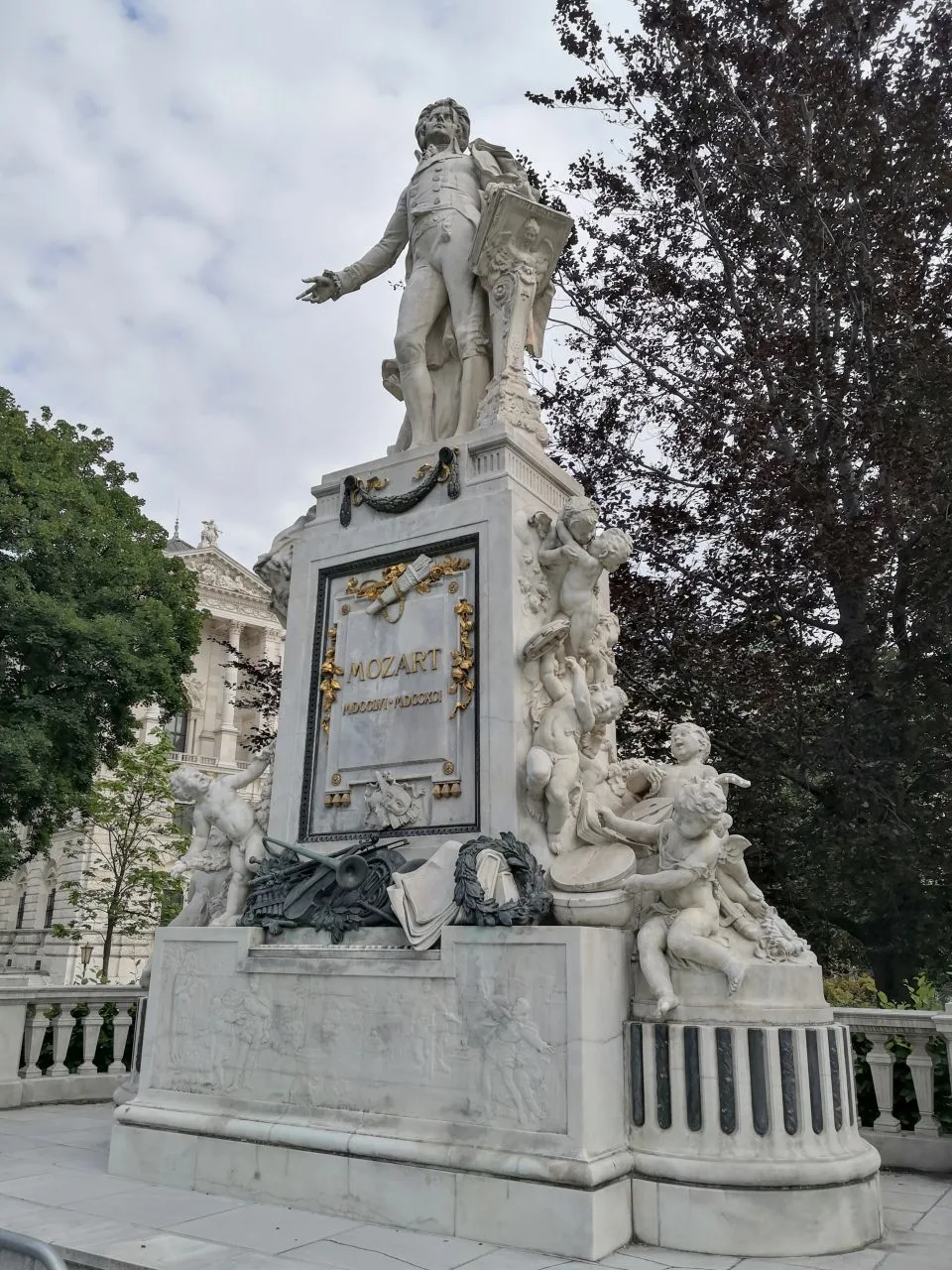
Mozart monument, Burggarten
Address
Josefsplatz 1, 1010 Wien
GPS
48.204265088391, 16.364777171127
Nestled in the heart of this enchanting city lies Burggarten, a picturesque park that is not only a haven for nature enthusiasts but also home to one of Vienna’s most beloved landmarks – the Mozart monument. This magnificent tribute to the legendary composer Wolfgang Amadeus Mozart stands proudly amidst lush greenery, capturing both the essence of his timeless melodies and the spirit of Vienna’s rich musical heritage.
Join me as we delve into the history, design, controversies, and significance surrounding this iconic Mozart monument in Burggarten. Let’s embark on a journey through Viennese history and explore how Mozart remains an eternal symbol in this vibrant capital!
History of the Mozart monument
The Mozart monument in Burggarten, Vienna, is a testament to the enduring legacy of one of the world’s greatest composers. But how did this iconic statue come to be? Let’s take a journey through history and explore the origins of this magnificent tribute.
The idea for the Mozart monument was being shared and developed among prominent Viennese and Austrians in an efforts to honor Austria’s cultural heritage. After years and decades of planning and fundraising, the monument was finally unveiled on April 21, 1896.
The monument was damaged by the bombing of Vienna on March 12, 1945, after which was restored and placed at its current location in the Burggaten on June 5, 1953.
Designed by Austrian sculptor Viktor Tilgner, and architect Karl König, the statue depicts Wolfgang Amadeus Mozart seated on a pedestal adorned with musical motifs and allegorical figures representing different aspects of his life and work. The attention to detail is truly remarkable, capturing not just Mozart’s physical likeness but also his creative spirit.

Since its creation over a century ago, the Mozart monument has become an integral part of Vienna’s cultural landscape. It serves as a gathering place for locals and tourists alike who come to pay their respects to this musical genius. The serene surroundings of Burggarten provide the perfect backdrop for contemplation and appreciation.
However, it hasn’t always been smooth sailing for this beloved landmark. Over the years, there have been debates about its location and even calls for its removal due to various reasons. Yet despite these controversies, the monument stands tall as a symbol of Vienna’s pride in its artistic heritage.
In addition to Burggarten, there are several other monuments dedicated to Mozart throughout Vienna that further highlight his significance in Austrian culture. From statues at Stadtpark and Albertinaplatz to memorials at Stephansplatz and Karlskirche Square – each pays homage to different facets of Mozart’s life and music.
Design and symbolism of the monument
The design of the Mozart monument in Burggarten is a testament to the artistic skill and creativity that Vienna is known for. Created by sculptor Viktor Tilgner, the monument stands tall and proud, capturing the essence of Mozart’s musical genius.
One of the most striking features of the statue is its dynamic pose. Mozart is depicted mid-stride, his coat flowing behind him as he seems to be lost in thought. This sense of movement reflects both his restless energy and his constant pursuit of musical perfection.

The attention to detail in Tilgner’s work is truly remarkable. From the delicate folds in Mozart’s clothing to the intricate carving on his violin, every aspect has been meticulously crafted. It is clear that this monument was created with love and admiration for one of history’s greatest composers.
On the front of the monument there is an invitation for the opera “Don Giovanni”, which was a reference to the opening performance of the State Opera. At the back, a high relief depicts the six-year-old composer at the piano, his father Leopold with the violin and his sister Nannerl singing.
Symbolically, the monument represents not only Mozart himself but also Vienna’s deep connection to music and culture. The presence of a lyre at Mozart’s feet serves as a reminder of his mastery over various instruments, while also symbolizing harmony and unity.
The symbolism within each carefully crafted detail reminds us all that genius like Mozarts does not fade away, it lives on eternally through their work.
Importance of Mozart in Vienna’s cultural identity
Vienna, the capital city of Austria, is renowned for its rich cultural heritage. And at the heart of this vibrant cultural tapestry lies one name that resonates through the ages – Wolfgang Amadeus Mozart. The importance of Mozart in Vienna’s cultural identity cannot be overstated.
Mozart was not only a prodigious composer but also a musical genius who revolutionized classical music. His compositions are treasured masterpieces that continue to captivate audiences worldwide. But it is in Vienna where his legacy truly thrives.

As a young man, Mozart made Vienna his home and found inspiration in its artistic atmosphere. He composed some of his most iconic works within these very streets – symphonies, operas, concertos that have become synonymous with Viennese culture.
The impact of Mozart’s music on Vienna’s cultural identity can be felt everywhere you go in the city. From grand concert halls to intimate chamber music venues, his melodies echo through each performance, enchanting both locals and visitors alike.
But beyond the realm of classical music, Mozart has permeated other aspects of Viennese culture as well. His influence can be seen in theater productions, art exhibitions, and even culinary experiences inspired by his time in Vienna.
Whether you’re strolling through Burggarten or attending a captivating orchestral performance at Musikverein or Staatsoper – you will undoubtedly feel the presence of Mozart, forever woven into the fabric of Vienna’s cultural
Controversies surrounding the monument
While the Mozart monument in Burggarten is undoubtedly a celebration of Vienna’s most beloved composer, it has not been without its fair share of controversies. Some have criticized the design and placement of the statue, questioning whether it truly does justice to Mozart’s legacy.
One point of contention is that the monument portrays Mozart in a somewhat idealized manner, with a youthful and cherubic face. Critics argue that this may not accurately capture his true appearance or convey his full complexity as an artist.

In addition, there have been debates about whether Burggarten was the appropriate location for such a significant tribute to Mozart. Some feel that other more prominent public spaces would have been better suited to honor his memory and contributions.
Furthermore, there are those who question whether dedicating an entire monument solely to Mozart disregards other important figures in Vienna’s musical history. Shouldn’t we also pay homage to composers like Beethoven or Strauss?
Despite these controversies, one cannot deny that the presence of the Mozart monument in Burggarten contributes to Vienna’s rich cultural landscape. It serves as a reminder of how deeply ingrained music is within this city’s identity and continues to inspire generations of musicians and art lovers alike.
Other notable monuments dedicated to Mozart in Vienna
Vienna, the city that holds a special place for Wolfgang Amadeus Mozart, has not limited its tribute to him with just one monument. In addition to the iconic Mozart monument in Burggarten, there are several other noteworthy installations dedicated to this musical genius scattered throughout the city.
One such notable landmark is the Mozarthaus Vienna, located in Domgasse 5. This was once the residence of Mozart himself from 1784 to 1787 and is now a museum showcasing his life and work. It provides visitors with an intimate glimpse into his daily life and offers insights into his creative process.
 Another remarkable tribute is found at St. Marx Cemetery where Mozart was buried in an unmarked grave after his untimely death at age 35. In recognition of his immense contributions to music, a memorial stone was placed there as a lasting commemoration of his legacy.
Another remarkable tribute is found at St. Marx Cemetery where Mozart was buried in an unmarked grave after his untimely death at age 35. In recognition of his immense contributions to music, a memorial stone was placed there as a lasting commemoration of his legacy.
The Vienna State Opera also pays homage by performing numerous works by Mozart regularly. Attending one of these performances allows you to experience firsthand how deeply ingrained he is within Vienna’s cultural fabric.
We have the Haus der Musik (House of Music), which celebrates not only Mozart but all aspects of Viennese music history. Here, visitors can immerse themselves in interactive exhibits that explore various composers’ lives and compositions including those of our beloved musical prodigy – Mozart!
These landmarks serve as reminders of how influential and enduring Mozart’s impact on music has been throughout history. They remind us that even though he lived centuries ago, his melodies continue resonating through time!
Conclusion: The enduring legacy of Mozart in Vienna’s history and culture
As we have explored the rich history and symbolism behind the Mozart monument in Burggarten, it becomes clear that Wolfgang Amadeus Mozart holds a special place in Vienna’s cultural identity. This iconic statue not only commemorates one of the greatest composers of all time but also serves as a testament to Vienna’s appreciation for artistic excellence.
 Mozart’s music continues to captivate audiences around the world, with his masterpieces performed in concert halls and opera houses on a regular basis. His influence can be felt not just in classical music but also across various genres, inspiring countless musicians throughout the centuries.
Mozart’s music continues to captivate audiences around the world, with his masterpieces performed in concert halls and opera houses on a regular basis. His influence can be felt not just in classical music but also across various genres, inspiring countless musicians throughout the centuries.
Vienna, known as the City of Music, owes much of its musical reputation to Mozart. His presence is deeply ingrained within this vibrant city, where his compositions were first brought to life during his prolific career. The sheer volume and brilliance of his work continue to shape Vienna’s cultural landscape today.
While there may be controversies surrounding certain aspects of the Mozart monument or differing opinions on its design or location, it cannot diminish the fact that Mozart remains an integral part of Vienna’s heritage. He embodies Viennese creativity and artistic genius like no other composer.
Visiting Burggarten and witnessing this magnificent tribute to Mozart is a must for any music lover or visitor interested in delving into Vienna’s fascinating past. It offers an opportunity to connect with both history and artistry at once – an experience that truly encapsulates what makes Vienna such a remarkable city.
In conclusion, let us celebrate the enduring legacy of Wolfgang Amadeus Mozart – through his timeless compositions and through monuments like those found in Burggarten – reminding us all that great artists leave an indelible mark on our collective consciousness.
